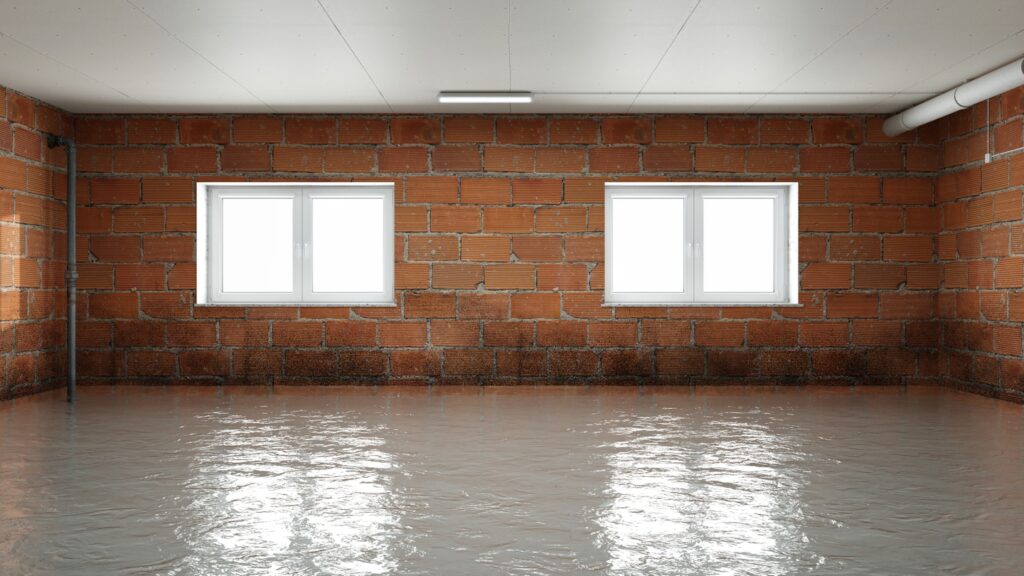Flooding in your basement can indeed be devastating, particularly in Prosper, TX, where heavy rains and flash floods are potential hazards. It can lead to structural damage, ruin personal belongings, and create health hazards due to contaminated water. Knowing how to handle such emergencies effectively involves taking immediate action to ensure safety, mitigate further damage by removing water and wet items promptly, and initiating thorough drying and disinfection processes. Seeking professional assistance from water damage restoration services in Prosper ensures that the cleanup and restoration are conducted efficiently and safely, minimizing the impact of flooding on your home and restoring a safe living environment.
Immediate Actions to Take When Your Basement Floods
Be Safe First
Before you do anything else, make sure you and your family are safe. Floodwater can pose numerous hazards, including electrical shocks, contamination, and structural damage.
Turn Off Electricity: If it’s safe to do so, turn off the power to the basement to avoid electrical hazards. If the circuit breaker is in the flooded area, do not attempt to access it. Instead, call an electrician.
Avoid Contact with Floodwater: Floodwater can be contaminated with sewage, chemicals, and other hazardous materials. Wear protective gear, such as rubber boots and gloves, if you need to enter the flooded area.
Evacuate if Necessary: If the flooding is severe and the structural integrity of your home is compromised, evacuate immediately and seek shelter elsewhere.
Stop the Source of Water
Identify and stop the source of water if possible. This could involve turning off the main water supply, fixing a burst pipe, or using sandbags to block incoming water during heavy rains.
Document the Damage
Take photos and videos of the flooded area and any damaged items. This documentation will be essential for insurance claims and for contractors to assess the extent of the damage.
Remove Water
Removing the water from your basement as quickly as possible is crucial to prevent further damage and mold growth. There are several methods you can use:
Pumps: Submersible pumps are effective for removing large amounts of water.
Wet/Dry Vacuums: These can be used for smaller amounts of water.
Buckets and Mops: For minor flooding, buckets and mops can be used, but they are labor-intensive and less efficient.
Dry the Area
Once the standing water is removed, the drying process begins. Use fans, dehumidifiers, and open windows to circulate air and reduce humidity. It’s important to dry the area thoroughly to prevent mold growth.
Clean and Disinfect
Floodwater can bring in contaminants, so it’s essential to clean and disinfect all surfaces. Use a solution of water and bleach (1 cup of bleach to 1 gallon of water) to disinfect the area. Be sure to wear protective gear and ventilate the area well.
Remove Damaged Items
Remove any items that have been damaged beyond repair, including furniture, carpets, and personal belongings. These items can retain moisture and contribute to mold growth.
Assessing and Repairing Damage
Inspect for Structural Damage
Once the area is dry, inspect your basement for structural damage. Look for cracks in the foundation, warped walls, or weakened support beams. If you notice any significant damage, consult a professional contractor.
Repair and Replace
Drywall and Insulation: Water-damaged drywall and insulation should be removed and replaced. Even if these materials appear dry, they can retain moisture and foster mold growth.
Flooring: Depending on the extent of the damage, you may need to replace carpeting, wooden floors, or tiles.
Electrical and Plumbing Systems: Have a professional inspect your electrical and plumbing systems for any damage and make necessary repairs.
Preventing Future Basement Flooding
Install a Sump Pump
A sump pump can help prevent basement flooding by automatically pumping water out of your basement and away from your home. Make sure to test it regularly and consider installing a battery backup in case of power outages.
Improve Drainage
Ensure that your home’s drainage system is effective:
Clean Gutters and Downspouts: Regularly clean gutters and downspouts to ensure they are free of debris and can direct water away from your home.
Grade the Landscape: The ground around your home should slope away from the foundation to prevent water from pooling near your house.
Seal Cracks and Openings
Inspect your basement walls and foundation for cracks and seal them with waterproof sealant. This can help prevent water from seeping in during heavy rains.
Install a Waterproof Membrane
Consider installing a waterproof membrane on the exterior of your basement walls. This additional layer can provide extra protection against water infiltration.
Regular Maintenance
Regularly inspecting and maintaining your home’s plumbing and drainage systems is crucial to prevent water damage. Promptly addressing any leaks and ensuring proper functionality can help mitigate potential risks. Services for water damage restoration Prosper can provide comprehensive assistance in restoring property integrity and safeguarding against future incidents.
Conclusion
Flooding in your basement can be a distressing and challenging event, but knowing how to respond effectively can help minimize damage and speed up the recovery process. Prioritize safety, remove water quickly, thoroughly dry and disinfect the area, and assess for structural damage. What to Do if Your Basement Floods in Prosper, TX Taking preventive measures, such as installing a sump pump, improving drainage, and sealing cracks, can help protect your basement from future flooding. By staying vigilant and proactive, you can safeguard your home and belongings from the detrimental effects of basement flooding in Prosper, TX.
FAQs
Is basement flooding covered by homeowners insurance?
Coverage for basement flooding varies by policy and insurer. Standard homeowners insurance typically covers water damage from burst pipes and appliance failures but may not What to Do if Your Basement Floods in Prosper, TX cover flood damage caused by natural disasters. Consider purchasing a separate flood insurance policy if you live in an area prone to flooding.
How can I tell if my basement is at risk for flooding?
Signs that your basement may be at risk for flooding include:
Water stains on walls or floors
Musty odors
Efflorescence (white powdery residue on walls)
Visible cracks in the foundation
History of flooding in the area
What should I do if I discover mold in my basement after flooding?
If you discover mold in your basement, it’s important to address it immediately. Small areas of mold can be cleaned with a solution of water and bleach. For larger infestations, or if the mold is causing health issues, it’s best to hire a professional mold remediation service.
How long does it take to dry out a flooded basement?
The time it takes to dry out a flooded basement depends on several factors, including the extent of the flooding, the temperature, and humidity levels. Generally, it can take anywhere from a few days to a week to thoroughly dry a basement. Using fans, dehumidifiers, and proper ventilation can speed up the process.
Should I attempt to clean up a flooded basement myself?
Whether you should attempt to clean up a flooded basement yourself depends on the extent of the flooding and the source of the water. For minor flooding and clean water (e.g., from a burst pipe), you can often handle the cleanup yourself. However, for severe flooding, contaminated water, or if you’re unsure about the safety of the situation, it’s best to hire a professional water damage restoration service.







